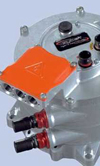Electric motors
 Energy recovery, based on the capture, storage and re-use of braking energy is not new in motorsport, and several series had pioneered the technology before Formula One embraced it and called it KERS - and then let go fairly quickly before embracing it again for 2011! Whatever the method of storage and redeployment of energy though, the aims are the same: either more power and a quicker lap time, or the same lap time with greater fuel conversion efficiency. Greater efficiency is in keeping with the aims of both the motor industry and various governments.
Energy recovery, based on the capture, storage and re-use of braking energy is not new in motorsport, and several series had pioneered the technology before Formula One embraced it and called it KERS - and then let go fairly quickly before embracing it again for 2011! Whatever the method of storage and redeployment of energy though, the aims are the same: either more power and a quicker lap time, or the same lap time with greater fuel conversion efficiency. Greater efficiency is in keeping with the aims of both the motor industry and various governments.
Among the early pioneers in motorsport applications of so-called 'regenerative braking' were UK company Zytek. It had a regenerative braking system racing in endurance sportscars more than a decade ago in a project with Panoz, and has remained active in the development of race 'hybrid' technology since then. A large part of the Zytek group works on the design, development and manufacture of hybrid and full electric drivetrains for the mainstream automotive industry, so access to the leading technology is not a problem for the racing arm of the company.
I had the chance to see the latest Zytek race hybrid electric motor at the LMES sportscar race at Silverstone in 2010, and was startled to see the progress that has been made in motor technology since the days when I was involved in the Panoz Q9 project. The new motor is aimed at the Le Mans prototype class, but would be suited to other types of racing. A successful manufacturer-backed test in 2010 showed its potential for high-level production-based endurance racing.
The power of the new motor is stated to be 55 kW (about 74 hp), and its mass is 8.5 kg. Compared to the Q9 motor, this one produces less power (mandated by regulations) but in terms of power density it has made huge strides, being about 200% better than the Q9. The basic technology of the motor remains the same, but constant development means that real improvements have been made.
My recollection of the Q9 was the amount of effort required to turn the output shaft. It felt like winding a cam over, an effect known as 'cogging'. The large spikes in the torque required to turn the motor, requiring real physical effort, have been replaced by a motor that can be turned easily with one finger. This, I was told, is a consequence of improvements in magnet technology and the construction of the motor.
The motor operates within the context of a much lighter system overall. The Q9 battery needed an engine hoist to lift and manoeuvre it, whereas the new Zytek battery can easily be lifted by one person. Motor, battery and electronics form the major part of the system mass which comes in at 42 kg, whereas reports suggest that the weight penalty of the Q9 system was about 170 kg. Much of the difference comes from improvements in battery power density and energy density, as discussed in an earlier article.
It has recently been announced that Rangoni Motorsport is to campaign a Zytek sportscar in 2011 using this ZPH (Zytek Performance Hybrid) system.
Fig. 1 - The ZPH hybrid motor is small and compact compared to its predecessors (Courtesy of Zytek Motorsport)
Written by Wayne Ward